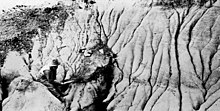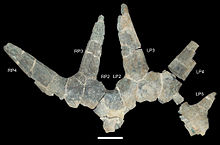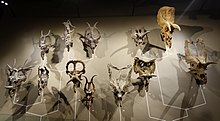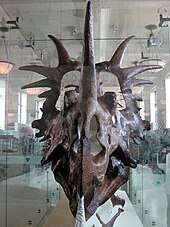Styracosaurus
| Styracosaurus | |
|---|---|

| |
| Holotype skeleton, Canadian Museum of Nature | |
| Scientific classification | |
| Domain: | Eukaryota |
| Kingdom: | Animalia |
| Phylum: | Chordata |
| Clade: | Dinosauria |
| Clade: | †Ornithischia |
| Clade: | †Ceratopsia |
| Family: | †Ceratopsidae |
| Subfamily: | †Centrosaurinae |
| Clade: | †Eucentrosaura |
| Tribe: | †Centrosaurini |
| Genus: | †Styracosaurus Lambe, 1913 |
| Type species | |
| †Styracosaurus albertensis Lambe, 1913
| |
| Other species | |
| |
| Synonyms | |
S. albertensis synonymy
S. ovatus synonymy
| |
Styracosaurus (
Styracosaurus was a relatively large dinosaur, reaching lengths of 5–5.5 metres (16–18 ft) and weighing about 1.8–2.7 metric tons (2.0–3.0 short tons). It stood about 1.8 meters (5.9 feet) tall. Styracosaurus possessed four short legs and a bulky body. Its tail was rather short. The skull had a beak and shearing cheek teeth arranged in continuous
Named by
Discoveries and species

The first fossil remains of Styracosaurus were collected in Alberta, Canada by C. M. Sternberg (from an area now known as Dinosaur Provincial Park, in a formation now called the Dinosaur Park Formation) and named by Lawrence Lambe in 1913. This quarry was revisited in 1935 by a Royal Ontario Museum crew who found the missing lower jaws and most of the skeleton. These fossils indicate that S. albertensis was around 5.5–5.8 metres (18–19 ft) in length and stood about 1.65 metres (5.4 ft) high at the hips.[4] An unusual feature of this first skull is that the smallest frill spike on the left side is partially overlapped at its base by the next spike. It appears that the frill suffered a break at this point in life and was shortened by about 6 centimeters (2.4 inches). The normal shape of this area is unknown because the corresponding area of the right side of the frill was not recovered.[5]

In the summer of 2006, Darren Tanke of the Royal Tyrrell Museum of Palaeontology in Drumheller, Alberta relocated the long lost S. parksi site.[5] Pieces of the skull, evidently abandoned by the 1915 crew, were found in the quarry. These were collected and it is hoped more pieces will be found, perhaps enough to warrant a redescription of the skull and test whether S. albertensis and S. parksi are the same. The Tyrrell Museum has also collected several partial Styracosaurus skulls.[8] At least one confirmed bone bed (bonebed 42) in Dinosaur Provincial Park has also been explored (other proposed Styracosaurus bone beds instead have fossils from a mix of animals, and nondiagnostic ceratopsian remains). Bonebed 42 is known to contain numerous pieces of skulls such as horncores, jaws and frill pieces.[5]
Several other species which were assigned to Styracosaurus have since been assigned to other genera. S. sphenocerus, described by
Styracosaurus ovatus

A species, Styracosaurus ovatus, from the
Though it was originally found to nest closer to Einiosaurus and later centrosaurines by McDonald and colleagues in both 2010 and 2011, revisions of phylogenetic analyses in 2013 by Scott Sampson and colleagues, and further expansions and modifications of the same dataset, instead placed Rubeosaurus ovatus as the sister taxon of Styracosaurus albertensis, as had been originally considered when the species was first named, though the two species were not moved into the same genus as originally named. A review of the variability within known Styracosaurus specimens by Robert Holmes and colleagues in 2020 found that USNM 11869, the type specimen of Rubeosaurus ovatus, fell within the variation seen in other specimens from the older deposits of the Dinosaur Park Formation S. albertensis is known from. While no phylogenetic analysis was conducted, previous results of updated analyses showed that Rubeosaurus ovatus and Styracosaurus albertensis were not distantly related, so the justification for naming the genus Rubeosaurus was not present, and the variability in Styracosaurus albertensis specimens also did not support the distinction of Styracosaurus ovatus, with Holmes et al. considering the latter a junior synonym of the former.[3] The conclusion of Holmes and colleagues was supported by a later 2020 study authored by Caleb Brown, Holmes, and Philip J. Currie, who described a new juvenile Styracosaurus specimen and determined that there were several specimens that are otherwise consistent with S. albertensis have been found with inward angled midline frill spikes, though not the same degree as S. ovatus. Though they considered that S. ovatus represented an extreme end of the S. albertensis variation not only in morphology but also as it was stratigraphically younger, they cautioned that at the least the current diagnosis of S. ovatus was inadequate.[15]

Later in 2020, the supposed specimen MOR 492 was redescribed by John Wilson and colleagues, who reinterpreted its anatomy in a way that contrasted McDonald and Horner who referred it to Styracosaurus ovatus. While Wilson et al. agreed that the close relationship between S. albertensis and S. ovatus meant that the genus name Rubeosaurus should be abandoned, they cautioned against synonymization. MOR 492 was moved into its own taxon,
Description

Individuals of the genus Styracosaurus were approximately 5–5.5 metres (16–18 ft) long as adults and weighed about 1.8–2.7 metric tons (2.0–3.0 short tons).
Aside from the large nasal horn and four long frill spikes, the cranial ornamentation was variable. Some individuals had small hook-like projections and knobs at the posterior margin of the frill, similar to but smaller than those in Centrosaurus. Others had less prominent tabs. Some, like the type individual, had a third pair of long frill spikes. Others had much smaller projections, and small points are found on the side margins of some but not all specimens. Modest pyramid-shaped brow horns were present in subadults, but were replaced by pits in adults.[5] Like most ceratopsids, Styracosaurus had large fenestrae (skull openings) in its frill. The front of the mouth had a toothless beak.
The bulky body of Styracosaurus resembled that of a rhinoceros. It had powerful shoulders which may have been useful in intraspecies combat. Styracosaurus had a relatively short tail. Each toe bore a hooflike ungual which was sheathed in horn.[17]
Various limb positions have been proposed for Styracosaurus and ceratopsids in general, including forelegs which were held underneath the body, or, alternatively, held in a sprawling position. The most recent work has put forward an intermediate crouched position as most likely.[20]
Classification
Styracosaurus is a member of the Centrosaurinae. Other members of the clade include Centrosaurus (from which the group takes its name),[21][22] Pachyrhinosaurus,[21][23] Avaceratops,[21] Einiosaurus,[23][24] Albertaceratops,[24] Achelousaurus,[23] Brachyceratops,[7] and Monoclonius,[21] although these last two are dubious. Because of the variation between species and even individual specimens of centrosaurines, there has been much debate over which genera and species are valid, particularly whether Centrosaurus and/or Monoclonius are valid genera, undiagnosable, or possibly members of the opposite sex. In 1996, Peter Dodson found enough variation between Centrosaurus, Styracosaurus, and Monoclonius to warrant separate genera, and that Styracosaurus resembled Centrosaurus more closely than either resembled Monoclonius. Dodson also believed one species of Monoclonius, M. nasicornis, may actually have been a female Styracosaurus.[25] However, most other researchers have not accepted Monoclonius nasicornis as a female Styracosaurus, instead regarding it as a synonym of Centrosaurus apertus.[5][26] While sexual dimorphism has been proposed for an earlier ceratopsian, Protoceratops,[27] there is no firm evidence for sexual dimorphism in any ceratopsid.[28][29][30]


The cladogram depicted below represents a phylogenetic analysis by Chiba et al. (2017):[31]
| Centrosaurinae |
| |||||||||||||||||||||||||||||||||||||||||||||||||||||||||||||||||||||||||||||||||||||||||||||||||||||||||||||||
Origins and evolution
The evolutionary origins of Styracosaurus were not understood for many years because fossil evidence for early ceratopsians was sparse. The discovery of Protoceratops, in 1922, shed light on early ceratopsid relationships,[32] but several decades passed before additional finds filled in more of the blanks. Fresh discoveries in the late 1990s and 2000s, including Zuniceratops, the earliest known ceratopsian with brow horns, and Yinlong, the first-known Jurassic ceratopsian, indicate what the ancestors of Styracosaurus may have looked like. These new discoveries have been important in illuminating the origins of horned dinosaurs in general, and suggest that the group originated during the Jurassic in Asia, with the appearance of true horned ceratopsians occurring by the beginning of the late Cretaceous in North America.[7]
Goodwin and colleagues proposed in 1992 that Styracosaurus was part of the lineage leading to Einiosaurus, Achelousaurus and Pachyrhinosaurus. This was based on a series of fossil skulls from the Two Medicine Formation of Montana.[33] The position of Styracosaurus in this lineage is now equivocal, as the remains that were thought to represent Styracosaurus have been transferred to the genus Rubeosaurus.[13]
Styracosaurus is known from a higher position in the formation (relating specifically to its own genus) than the closely related Centrosaurus, suggesting that Styracosaurus displaced Centrosaurus as the environment changed over time and/or dimension.[26] It has been suggested that Styracosaurus albertensis is a direct descendant of Centrosaurus (C. apertus or C. nasicornis), and that it in turn evolved directly into the slightly later species Rubeosaurus ovatus. Subtle changes can be traced in the arrangement of the horns through this lineage, leading from Rubeosaurus to Einiosaurus, to Achelousaurus and Pachyrhinosaurus. However, the lineage may not be a simple, straight line, as a pachyrhinosaur-like species has been reported from the same time and place as Styracosaurus albertensis.[2]
In 2020, during the description of Stellasaurus, Wilson et al. found Styracosaurus (including S. ovatus) to be the earliest member of a single evolutionary lineage that eventually developed into Stellasaurus, Achelousaurus, and Pachyrhinosaurus.[14]
Paleobiology

Styracosaurus and other horned dinosaurs are often depicted in popular culture as herd animals. A bonebed composed of Styracosaurus remains is known from the Dinosaur Park Formation of Alberta, about halfway up the formation. This bonebed is associated with different types of river deposits.[8][34] The mass deaths may have been a result of otherwise non-herding animals congregating around a waterhole in a period of drought, with evidence suggesting the environment may have been seasonal and semi-arid.[35]
Dentition and diet
Styracosaurs were
Ceratopsid teeth, including those of Styracosaurus, were arranged in groups called batteries. Older teeth on top were continually replaced by the teeth underneath them. Unlike
Horns and frill

The large nasal horns and frills of Styracosaurus are among the most distinctive facial adornments of all dinosaurs. Their function has been the subject of debate since the first horned dinosaurs were discovered.
Early in the 20th century, paleontologist
It was long believed that ceratopsians like Styracosaurus used their frills and horns in defence against the large predatory dinosaurs of the time. Although pitting, holes, lesions, and other damage on ceratopsid skulls are often attributed to horn damage in combat, a 2006 study found no evidence for horn thrust injuries causing these forms of damage (for example, there is no evidence of infection or healing). Instead, non-pathological bone resorption, or unknown bone diseases, are suggested as causes.[45]

However, a newer study compared incidence rates of skull lesions in Triceratops and Centrosaurus and showed that these were consistent with Triceratops using its horns in combat and the frill being adapted as a protective structure, while lower pathology rates in Centrosaurus may indicate visual rather than physical use of cranial ornamentation, or a form of combat focused on the body rather than the head;[46] as Centrosaurus was more closely related to Styracosaurus and both genera had long nasal horns, the results for this genus would be more applicable for Styracosaurus. The researchers also concluded that the damage found on the specimens in the study was often too localized to be caused by bone disease.[47]
The large frill on Styracosaurus and related genera also may have helped to increase body area to regulate body temperature,[48] like the ears of the modern elephant. A similar theory has been proposed regarding the plates of Stegosaurus,[49] although this use alone would not account for the bizarre and extravagant variation seen in different members of the Ceratopsidae.[7] This observation is highly suggestive of what is now believed to be the primary function, display.
The theory of frill use in sexual display was first proposed in 1961 by Davitashvili. This theory has gained increasing acceptance.[28][50] Evidence that visual display was important, either in courtship or in other social behavior, can be seen in the fact that horned dinosaurs differ markedly in their adornments, making each species highly distinctive. Also, modern living creatures with such displays of horns and adornments use them in similar behavior.[51]
The use of the exaggerated structures in dinosaurs as species identification has been questioned, as no such function exists in vast majority of modern species of tetrapods (terrestrial vertebrates).[52]
A skull discovered in 2015 from a Styracosaurus indicates that individual variation was likely commonplace in the genus. The asymmetrical nature of the horns in the specimen has been compared to deer, which often have asymmetrical antlers in various individuals. The study carried out may also indicate that the genus Rubeosaurus may be synonymous with Styracosaurus as a result.[3]
Paleoecology

Styracosaurus is known from the Dinosaur Park Formation, and was a member of a diverse and well-documented
The Dinosaur Park Formation is interpreted as a low-relief setting of
In the Two Medicine Formation, dinosaurs that lived alongside Styracosaurus ovatus included the basal
See also
References
- ISBN 978-0-19-910207-5.
- ^ John R. Horner(2010). "New Material of "Styracosaurus" ovatus from the Two Medicine Formation of Montana". Pages 156–168 in: Michael J. Ryan, Brenda J. Chinnery-Allgeier, and David A. Eberth (eds), New Perspectives on Horned Dinosaurs: The Royal Tyrrell Museum Ceratopsian Symposium, Indiana University Press, Bloomington and Indianapolis, IN.
- ^ S2CID 210260909.
- ^ ISBN 978-0-691-05900-6.
- ^ S2CID 86218327. Retrieved August 19, 2010.
- ^ hdl:2246/2191.
- ^ ISBN 0-520-24209-2.
- ^ ISBN 978-0-253-34595-0.
- ^ Lambe, L. M. (1915). "On Eoceratops canadensis, gen. nov., with remarks on other genera of Cretaceous horned dinosaurs". Canada Geological Survey Bulletin, Geological Series. 12 (24): 1–49.
- ISBN 978-0-89950-917-4.
- ISBN 978-0-89950-917-4.
- .
- ^ John R. Horner(2010). "New Material of "Styracosaurus" ovatus from the Two Medicine Formation of Montana", In: Michael J. Ryan, Brenda J. Chinnery-Allgeier, and David A. Eberth (eds.), New Perspectives on Horned Dinosaurs: The Royal Tyrrell Museum Ceratopsian Symposium, Indiana University Press, pp. 656
- ^ PMID 21853043.
- S2CID 218945057.
- ^ PMID 32431910.
- ^ ISBN 1-56458-304-X.
- ISBN 978-0-691-13720-9.
- ^ Lambe, L.M. (1913). "A new genus and species from the Belly River Formation of Alberta". Ottawa Naturalist. 27: 109–116.
- ^ Thompson, Stefan; Holmes, Robert (April 2007). "Forelimb stance and step cycle in Chasmosaurus irvinensis (Dinosauria:Neoceratopsia". Palaeontologia Electronica. Retrieved May 28, 2007.
- ^ ISBN 978-0-521-36672-4.
- S2CID 220410105.
- ^ S2CID 128478038.
- ^ S2CID 130607301.
- ISBN 0-691-02882-6.
- ^ ISBN 978-0-253-34595-0.
- ^ Dodson, P. "Quantitative aspects of relative growth and sexual dimorphism in Protoceratops". Journal of Paleontology. 50: 929–940.
- ^ a b c Forster, C. A. (1990). The cranial morphology and systematics of Triceratops, with a preliminary analysis of ceratopsian phylogeny. Ph.D. Dissertation. University of Pennsylvania, Philadelphia. 227 pp. OCLC 61500040
- S2CID 132807103.
- .
- S2CID 134031275.
- ISBN 0-691-02882-6.
- S2CID 4283438.
- ^ Although this article mentioned two bonebeds, including BB 156, the recent review by Ryan et al. only accepted BB 42.
- JSTOR 3514834.
- S2CID 85280946.
- ^ Tait, J.; Brown, B. (1928). "How the Ceratopsia carried and used their head". Transactions of the Royal Society of Canada. 22: 13–23.
- PMID 28562975.
- S2CID 12547312.
- ISBN 0-521-32357-6.
- ISBN 0-691-02882-6.
- .
- .
- ISBN 0-691-02882-6.
- ISBN 0-253-34817-X.
- PMID 19172995.
- ^ Wall, Michael (January 27, 2009). "Scars Reveal How Triceratops Fought –". Wired.com. Retrieved August 3, 2010.
- S2CID 4160470.
- S2CID 44506996.
- ^ Davitashvili, L. (1961). The Theory of sexual selection. Izdatel'stvo Akademii Nauk SSSR. p. 538.
- PMID 28555861.
- S2CID 17827309.
- ISBN 0-520-24209-2
- ^ Eberth, David A. "The geology", in Dinosaur Provincial Park, pp. 54–82.
- ^ Braman, Dennis R., and Koppelhus, Eva B. "Campanian palynomorphs", in Dinosaur Provincial Park, pp. 101–130.
